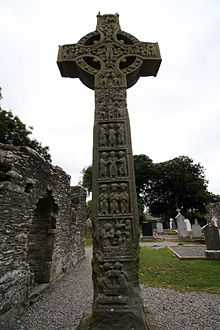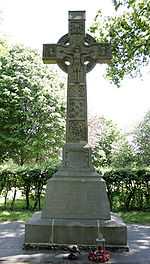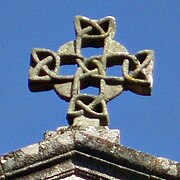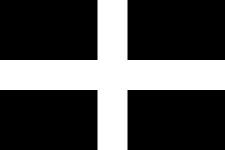Celtic cross



Celtic cross (Irish: cros Cheilteach,[1] Scottish Gaelic: crois Cheilteach, Manx: crosh Cheltiagh, Welsh: croes Geltaidd, Cornish: krows keltek, Breton: kroaz geltek) is a symbol that combines a cross with a ring surrounding the intersection. It belongs to a wider group of crosses with a nimbus.[2] In the Celtic Christian world it was combined with the Christian cross and this design was often used for high crosses – a free-standing cross made of stone and often richly decorated.[3] With the Celtic Revival the shape, usually decorated with interlace and other motifs from Insular art, became popular for funerary monuments and other uses, and has remained so, spreading well beyond Ireland.
Christian usage
Ireland and Britain

A distinctive Insular tradition of erecting monumental stone high crosses began by the 8th century, and possibly earlier. They probably followed earlier versions in wood, perhaps faced in metalwork. Some of these 'Celtic' crosses bear inscriptions in ogham. Standing crosses in Ireland and areas under Irish influence tend to be shorter and more massive than their Anglo-Saxon equivalents, which have mostly lost their headpieces, and therefore perhaps required the extra strength provided by the ring. Irish examples with a head in Celtic cross form include the Cross of Kells, Ardboe High Cross, the crosses at Monasterboice, and the Cross of the Scriptures, Clonmacnoise, as well as those in Scotland at Iona and the Kildalton Cross, which may be the earliest to survive in good condition. There are surviving free-standing crosses in Cornwall, including St Piran's cross at Perranporth, and Wales.[4] Other stone crosses are found in the former Northumbria and Scotland, and further south in England, where they merge with the similar Anglo-Saxon cross making tradition, in the Ruthwell Cross for example. Most examples in Britain were destroyed during the Protestant Reformation. By about 1200 the initial wave of cross building came in to an end in Ireland.
In Ireland, it is a popular legend that the Celtic Christian cross was introduced by Saint Patrick or possibly Saint Declan during his time converting the pagan Irish, though there are no examples from this early period. It has often been claimed that Patrick combined the symbol of Christianity with the sun cross, to give pagan followers an idea of the importance of the cross by linking it with the idea of the life-giving properties of the sun. Other interpretations claim that placing the cross on top of the circle represents Christ's supremacy over the pagan sun.
- Notable Celtic high crosses in Ireland
- Ahenny, County Tipperary
- Ardboe County Tyrone
- Carndonagh, County Donegal
- Drumcliff, Co. Sligo
- Dysert O'Dea Monastery, County Clare
- Glendalough County Wicklow St. Kevin's Cross
- Killamery, County Kilkenny
- Fahan, County Donegal
- Monasterboice, County Louth
- Clonmacnoise Cross of the Scriptures, County Offaly
- Clonmacnoise North Cross, County Offaly
- Clonmacnoise South Cross, County Offaly
- Kells, County Meath
- Moone, County Kildare
- Notable Celtic high crosses in Scotland
- Iona Abbey Crosses
- Inchbraoch Cross
- Kildalton Cross
- Meigle 1 Cross
- St. Martins Cross
Continental Europe
France
There are similar crosses in France, which some specialists think are influenced by those from Ireland. But the correct expression to define the continental crosses is "cross with nimbus" (croix nimbée in French). Their design is different, but all the French examples are quite analogous in shape to each other. They are found mainly in the western part of France, in Normandy, Brittany, and Limousin as far as Auvergne in the centre. Most of them were made around the 15th century. One can be seen on the spire of Sainte-Croix cathedral at Orléans, in the Loire valley.
In Lower Normandy, in Cotentin, many churches have kept their tombstones decorated with a Celtic cross.[5][6]
-
Normandy, Veules-les-Roses Cross
-

Normandy, Saint-Pierre-en-Port Cross
-

Brittany, Sant-Kadoù Island, Stêr an Intel (Étel river)
-

Auvergne, details of a high cross at Chambon-sur-Lac
-

Normandy, Tombstones in the St Germain church, Flamanville
Galicia
In Galicia a distinct form of cross similar to the Insular Celtic shapes is found, often topping horreos (granaries) as a protective measure against any kind of evil.[7] They can also be found atop churches, and since the beginning of the 20th century in cemeteries, but they are unusual in cruceiros (high crosses). A very characteristic Galician style[8] combines a Celtic cross with a Celtic simple knot. It is similar to the St Maur cross at Glanfeuil Abbey[9][10] that could have been made between the 9th and the 11th century.
-

Modern copy of the Romanesque Agnus Dei topping the church of Saint Mary Salome, in Santiago de Compostela
-
Gothic cross atop the church of Saint Susanna, in Santiago de Compostela
-

A Latin cross and a Celtic cross atop a Galician hórreo (granary)
-

Celtic crosses topping the sanctuary of a Virxe da Barca ('Our Lady of the Boat'), Muxía
-

Cross topping the church of Saint Lazarus, Santiago de Compostela
Baltic States

In Estonia, further examples can be found, notably on the Islands (Saaremaa, Hiiumaa).
Modern times
Celtic Revival
The Celtic Revival of the mid-19th century led to an increased use and creation of Celtic crosses in Ireland. In 1853 casts of several historical high crosses were exhibited to interested crowds at the Dublin Industrial Exhibition. In 1857, Henry O'Neill published Illustrations of the Most Interesting of the Sculptured Crosses of Ancient Ireland. These two events stimulated interest in the Celtic cross as a symbol for a renewed sense of heritage within Ireland.
New versions of the high cross were designed as fashionable cemetery monuments in Victorian Dublin in the 1860s. From Dublin the revival spread to the rest of the country and beyond. Since the Celtic Revival, the ringed cross became an emblem of Celtic identity, in addition to its more traditional religious symbolism.[11] Alexander and Euphemia Ritchie, working on the Isle of Iona in Scotland from 1899 to 1940, popularised use of the Celtic Cross in jewellery.[12]
-

Modern Celtic cross of a war monument in Limburg-Dietkirchen, Germany
-

Modern Celtic cross at cimetière du Père-Lachaise, Paris
Since its revival in the 1850s, the Celtic cross has been used extensively as grave markers. This was a departure from medieval usage, when the symbol was more typically used for a public monument. The Celtic cross now appears in jewellery, T-shirts, tattoos, coffee cups and other retail items. Both the Gaelic Athletic Association and the Northern Ireland national football team have used versions of the Celtic cross in their logos and advertising.
-

Former crest of the Gaelic Athletic Association
-

Original crest of the Irish Football Association
White nationalist usage

The Celtic cross is one of the most popular symbols used by individuals and organisations to represent white nationalism, white supremacy,[13][14] Neo-Nazism,[15] and white pride;[16] it is used as the logo for white nationalist hate site[17] Stormfront.org.[18]
In Germany, the Celtic cross was adopted by a prohibited political party (VSBD/PdA) leading to a ban of the symbol if used within a context of promoting racism (cf. Strafgesetzbuch section 86a). Although there were doubts on the constitutionality of the ban[19] it was upheld in a decision of the supreme court.[20]
In Italy there is a similar ban, deriving from Legge Mancino[21] (Mancino Act, from the Minister of Interior who enacted the law), although there are some examples of the use of the Celtic Cross as a Roman Catholic Church symbol in Northern Italy.
Zodiac Killer
In the United States, a symbol resembling the Celtic Cross was adopted and used by the Zodiac Killer to sign letters written to various newspapers between 1 August 1969 and 29 January 1974. The significance of this symbol to the killer, if any, is unknown.
See also
- Basalt cross
- Conciliation cross
- Coptic cross
- Forked cross
- High cross
- Irminsul
- Maypole
- Arevakhach
- Picture stone
- Shaft cross
- Solar symbol
- Stone cross
- Sun cross
- Triumphal cross
Notes
- ↑ Dictionary of Irish Terms
- ↑ A nimbus is an indication of radiant light drawn around the head of a saint or a crosfs, related to a halo.
- ↑ Werner 98
- ↑ Langdon, Arthur G. (1896) Old Cornish Crosses. Truro: J. Pollard
- ↑ Frédéric Scuvée, Les croix nimbées du Cotentin in Heimdal n°2, 1971.
- ↑ Stéphane Laîné, Baligan ou les avatars d'un émir », in Remembrances et Resveries, Recueil d'articles en hommage à Jean Batany rassemblés et édités par Huguette Legros, Denis Hüe et Joël Grisward, Orléans, Éditions Paradigme.
- ↑ Mariño Ferro, Xosé Ramón (2010). Dicionario de etnografia e antropoloxía de Galiza (1 ed.). Vigo: Nigra Trea. p. 212. ISBN 978-84-95364-84-5.
- ↑ "There are many types of (church roof) crosses, but the interlaced ones are the most characteristic and the most flamboyant of all those to be found throughout the country (Galicia). They are made up, in most cases, by a Christian cross of equal arms, not unlike a Pate or Greek cross, with a circle that surrounds it; along with this, the cross is ornamented with interlaces in the way of the purest early Celtic art" ("Hai cruces antefixas de moitos tipos pero son as entrelazadas as máis chamativas e características de todas as que podemos atopar polo país. Están formadas na maior parte dos casos por unha cruz cristiá xeralmente de brazos iguais, do tipo da cruz de paté ou grega, e un circulo que a rodea; xunto con isto está ornamentada cun entrelazado da máis pura arte celta primitiva") Romero, Bieito (2009). Xeometrías máxicas de Galicia. Vigo: Ir Indo. pp. 122–176. ISBN 978-84-7680-639-5.
- ↑ The meaning of the St Maur cross (French)
- ↑
- ↑ Stephen Walker, "Celtic Revival Crosses", Celtic Arts Website, accessed 22 November 2008
- ↑ "A Brief History of the Ritchies", Alexander Ritchie Website, accessed 20 Nov 208
- ↑ http://www.scrippsmedia.com/tmj4/news/165199206.html
- ↑ http://www.adl.org/combating-hate/hate-on-display/c/celtic-cross.html#.VSQKEHBiHws
- ↑ http://www.adl.org/combating-hate/hate-on-display/c/celtic-cross.html#.VSQKEHBiHws
- ↑ "Hate Symbols: Celtic Cross – From A Visual Database of Extremist Symbols, Logos and Tattoos", Anti-Defamation League, accessed 23 July 2010
- ↑ https://books.google.ie/books?id=TqAAOLm7Y-MC&pg=PA363&dq=%22hate+site%22+stormfront&hl=en&sa=X&ei=JQskVfGrGYvTaMTDgKgJ&ved=0CBMQ6AEwAA#v=onepage&q=%22hate%20site%22%20stormfront&f=false
- ↑ https://books.google.ie/books?id=_cGjWX8_RpgC&pg=PA10&dq=%22celtic+cross%22+stormfront&hl=en&sa=X&ei=7gokVavzFY3watf5gIgH&ved=0CBgQ6AEwAQ#v=onepage&q=%22celtic%20cross%22%20stormfront&f=false
- ↑ Andreas Stegbauer, "The Ban of Right-Wing Extremist Symbols according to Section 86a of the German Criminal Code", German Law Journal, No.2, 1 Feb 2007, accessed 22 November 2008
- ↑ Pressemitteilung Nr. 209/08
- ↑ Legge 205/1993
References
- Werner, Martin (1990). "On the Origins of the Form of the Irish High Cross". Gresta (Gesta, Vol. 29, No. 1) 29 (1): 98–110. JSTOR 767104.
- H. Richardson: An introduction to Irish high crosses. 1990, ISBN 0-85342-941-3.
- J. Romilly Allen: Early Christian symbolism in Great Britain and Ireland before the thirteenth century. Whiting, London 1887. Neuauflage als The High Crosses of Ireland. Felinfach: Llanerch 1992, ISBN 0-7661-9262-8.
- Peter Harbison: The high crosses of Ireland. Habelt, Bonn, 3 Baende, 1991.
External links
| Wikimedia Commons has media related to Celtic crosses. |
- David Dimbleby. "Age of Conquest". Seven Ages of Britain. 29:16 minutes in. BBC 1. Retrieved 21 Nov 201. Check date values in:
|accessdate=(help) - Community network for people with Celtic interests.
- Celtic Crosses – Symbolism and History.
- Is the Celtic Cross a Pagan Symbol?
- Origins and Design of the Celtic Cross.
- Cornish crosses, by Andrew Langdon
- Stephen Walker, "Celtic Cross History and Symbolism"
| ||||||||||||||||||||||||||||||||||||||||||||||||||||||||
| ||||||||||||||||



